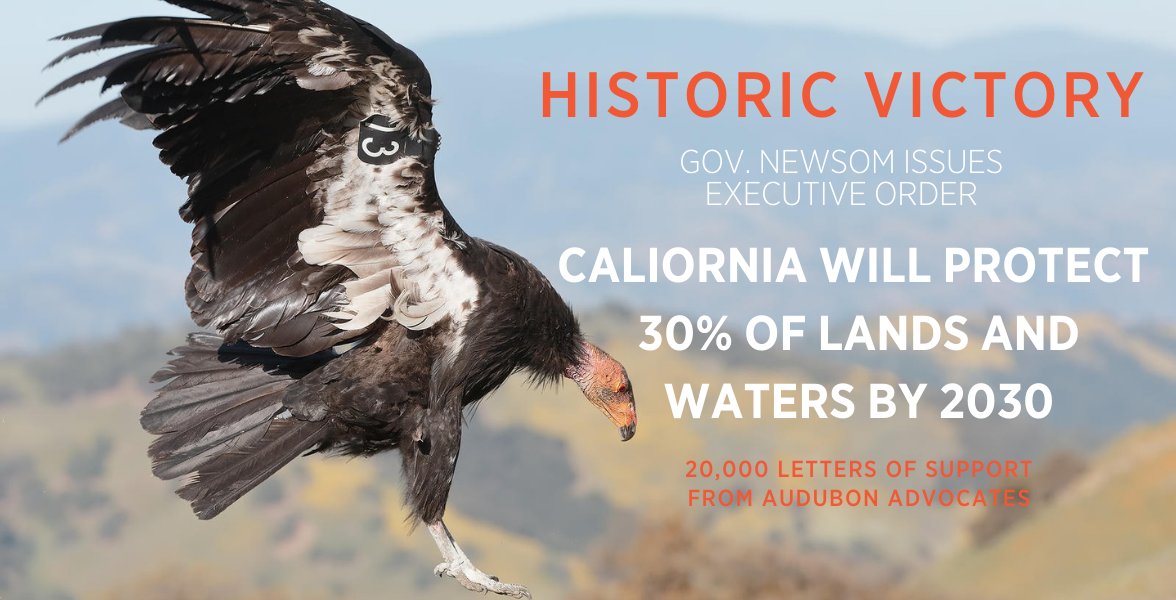
(Sacramento—Oct. 7, 2020) California Gov. Gavin Newsom today issued a sweeping executive order today directing state agencies to catalogue, study and protect the state’s diversity of wildlife species. The order also directs those agencies to develop nature-based solutions to address climate change which will sequester carbon, create wildlife habitat, and benefit all Californians, especially those living in disadvantaged communities.
“People and wildlife in California are already suffering from wildfire, drought, and disease because we have not done enough to protect nature, address climate change, and build healthy and resilient communities” said Mike Lynes, director of public policy for Audubon California. “Governor Newsom’s executive order is an emphatic commitment that California will lead to protect our shared natural resources. As California works towards its 30 by 30 goal and to protect biodiversity, Audubon California is committed to ensuring that these programs include and provide benefits to communities that have been deprived of fresh water, healthy air, and access to nature. ”
Governor Newsom’s announcement follows the effort led by Assemblymember Ash Kalra (D-San Jose), who authored Assembly Bill 3030 this year to set a goal for the state to protect 30 percent of its lands and waters by the year 2030, and to ensure access to nature for all Californians, especially those living in nature-deprived communities. The “30 by 30” effort is an international movement to set aside 30 percent of the earth’s land area to preserve wildlife habitat and protect against climate change. It also recognizes the rights, stewardship, and experience of indigenous peoples in managing natural resources. It prioritizes ensuring that the benefits of cleaner lands, waters, and air are shared by all.
“California’s natural resources are for everyone,” said Juan Altamirano, deputy director of policy for Audubon California. “We will be a healthier and more resilient state only if all Californians benefit from efforts to protect habitats, wildlife, air and water. To succeed, the state will need input from all stakeholders, especially those from frontline communities that are enduring the impacts of climate change now and that have historically been excluded from decision-making regarding clean air, fresh water, and access to nature.”
Globally, wildlife and native plant diversity and abundance is plummeting. Audubon’s Survival by Degrees report concluded that at least 389 bird species in North America are at risk of extinction due to climate change. California is home to more species of plants and animals than any other in the United States and conservation here will benefit many species of birds that migrate on the Pacific Flyway.
The 30x30 effort is also an opportunity to close “the nature gap”. Due to historic racism and settlement practices, people of color in the United States are much more likely to live in communities that are nature-deprived, with less access to parks, open space, wildlife, and native plants. Moreover, people of color have often been actively excluded from participating in natural resource decisions or nature-based activities.
“Access to nature has direct impacts on people’s health and quality of life,” Altamirano said. “In order to implement 30x30 successfully, the state of California and all stakeholders must ensure that people of color and communities that have been traditionally been excluded from the conservation movement are included, welcomed, and listen to.”
The executive order also directs state agencies to develop a “natural and working lands climate smart strategy”, which will develop programs that promote healthy land management practices to sequester carbon in plants and soil, provide habitat, and continue appropriate farming, ranching, and other economic activities on California’s working lands.
“California cannot meet its carbon sequestration and climate adaptation goals without investing in climate-smart strategies on working lands,” said Meghan Hertel, director of land and water conservation at Audubon California. “Programs like Audubon Conservation Ranching are developing new methods for ranchers to continue their operations while increasing carbon sequestration in rangeland soils, improving diversity of native plants, and providing habitat for imperiled grassland birds and other species.”
###
Media Contact: Jason Howe, 415-595-9245; jason.howe@audubon.org
About Audubon
The National Audubon Society protects birds and the places they need, today and tomorrow. Audubon works throughout the Americas using science, advocacy, education, and on-the-ground conservation. State programs, nature centers, chapters, and partners give Audubon an unparalleled wingspan that reaches millions of people each year to inform, inspire, and unite diverse communities in conservation action. A nonprofit conservation organization since 1905, Audubon believes in a world in which people and wildlife thrive. Learn more at www.audubon.org and on Facebook, Twitter and Instagram @audubonsociety.



